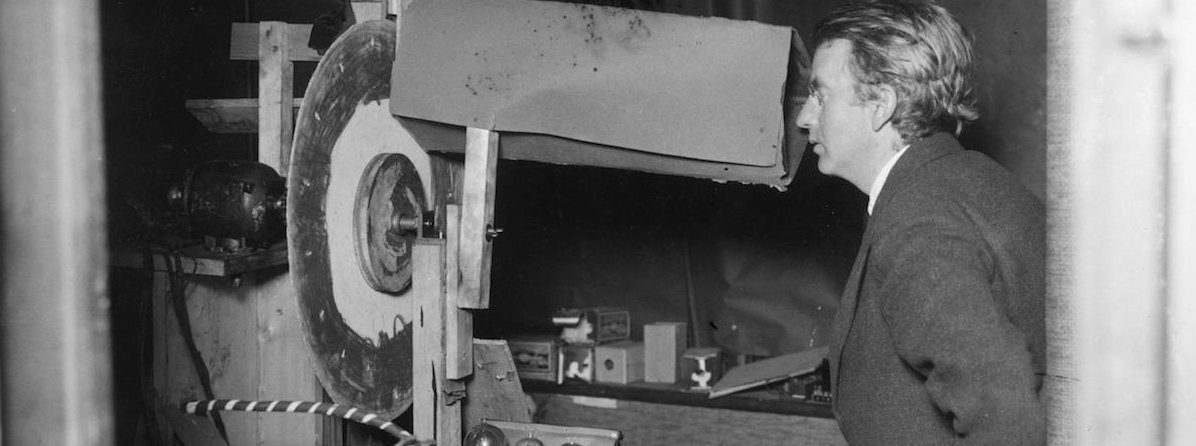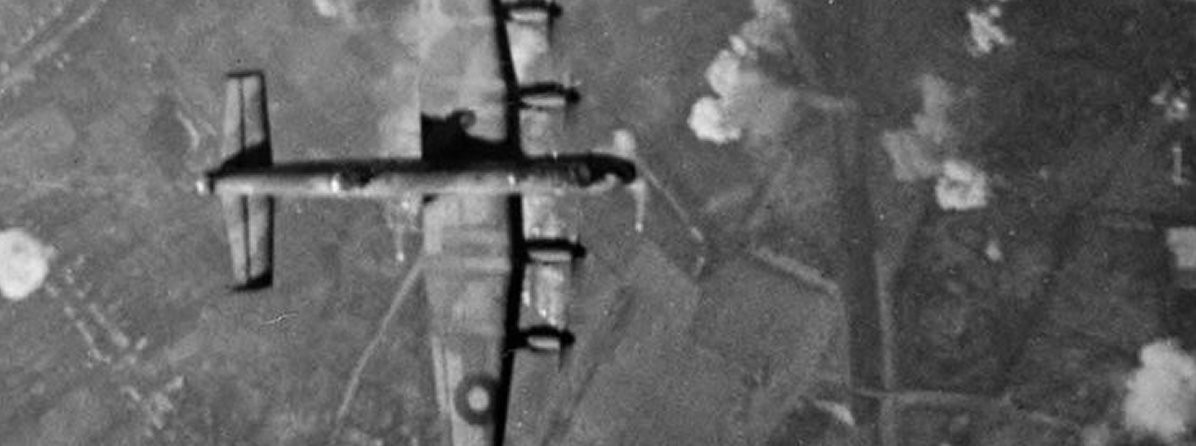
John Logie Baird - Television, Secret Experiments, Sabotage, Lies - Chapter 4
John Logie Baird - Chapter 4: Sabotage
Described by the New York Times as "the single most dominating influence on British broadcasting," John Reith was born the fifth son of a Scottish minister and trained in Glasgow as an engineer. But his heart was not in engineering as he would later write; 'I would a thousand times rather see a sunset than the most wonderful piece of engineering in the world'. Looking for something more interesting to pursue, Reith answered an advertisement in 1922 for a post at the newly formed BBC. Of his interview he said; 'they didn't ask me many questions, and some they did, I didn't know the answers to. The fact is, I hadn't the remotest idea what broadcasting was'. He was hired and a year later became managing director.
Zealous, high-minded, deeply religious, authoritarian, driven, difficult, lonely and self-absorbed, Reith would define the character, ethos and ambition of the BBC more than any other person in its history. His strong moral principles led him to fire people when he learnt they were homosexuals, he refused to allow a divorcée to play the violin on the radio, and unbelievably for someone in his position, was deeply uncomfortable with popular culture in general. Excerpts published in 1975 from his personal diaries showed him to be a man with strong convictions, powerful hatreds, considerable frustration, and an immense ego. He was a Nazi sympathiser who hated Winston Churchill. 'The site of Churchill naturally bothered me. I absolutely hate him', he wrote, although he served Great Britain between 1940 and 1950 as a cabinet minister and naval officer.
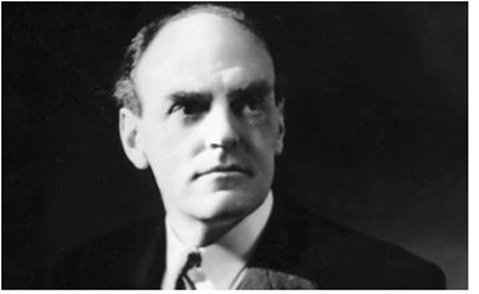
Although Reith's strong self-righteous convictions served the BBC well in its early days, it rendered him incapable of dealing gracefully with inevitable change as the broadcast organization matured. By the late 1930s the system he had built was running smoothly. In a managerial coup in mid-1938 Reith was eased out as Director General by the BBC's Board of Governors. After 16 years, Reith left the BBC with a considerable bitterness that he harboured the rest of his life.
Reith had no time for television. Even On 2nd November 1936 when the world's first regular high-definition service began transmitting to the 100 or so TV sets available in Britain, Reith had little enthusiasm for the new medium, noting in his diary, 'To Alexandra Palace for the television opening, I have declined to be televised or take part...'
It would not be possible to say with clear conviction that John Reith deliberately stood in the way of early television development in Britain in the late 1920's. But given that he was the single most dominating influence on British broadcasting at that time, it would be impossible to ignore that possibility. Another startling fact is that in both his published diaries and his 1947 biography, John Reith makes no mention of John Logie Baird whatsoever. This is quite amazing when the history of the BBC is so closely tied to the history of television itself, but not so surprisingly out of character for Reith, who was a very egotistical man. Whilst he often sought honours for himself, he deeply resented any awards made to others. In 1963 he wrote of the Queen's New Year Honours list, 'The honours I have abundantly earned and not received would take a whole page.'
Another opponent of television at the BBC was their chief engineer, Captain P. P. Eckersley, who was completely against the commercial use of 30-line television because he believed it would disappoint the public. At that point 30-lines was enough to show head and shoulder images and no more, and Eckersley argued that making it more effective would make great demands on the already overcrowded medium wavelengths.
In early 1929, with controversy raging around Baird's system and achievements, he was challenged by some die-hard critics to demonstrate improvements in his system. In response Baird gave the first exhibition of whole stage scenes to visitors to his laboratory. Ronald Tiltman reported the events: 'We saw two boxers fighting on a stage about 15 feet by 10 feet, and on the small reception screen witnessed clearly the exchange of blows. Baird also at this time succeeded in projecting his received images on to a larger screen, some four feet in diameter, thus permitting them to be viewed by greater numbers.'
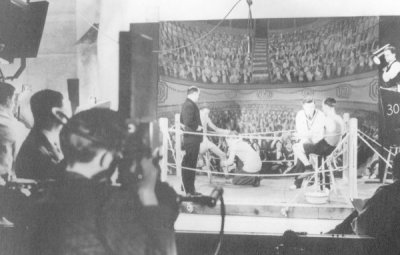
The visitors' book at Baird's laboratory included a number of distinguished guests, amongst them Sir William Mitchell Thompson, the then Postmaster General, who was so suitably impressed that he afterwards stated in Parliament that television was to be tested by broadcasting. On 5th March 1929 the official test of Baird's system took place at 2LO in the presence of Post Office Officials, BBC officials and a committee of Members of Parliament. Receivers were installed at Savoy Hill and at a room in the Secretary's Department, General Post Office, EC1. Baird himself wrote: 'It was a nerve-racking ordeal, as we were to stand or fall by the result of one crucial demonstration. If a wire were to slip or a valve burn out at a critical moment, the demonstration would fail and we should be faced by a devastating fiasco. The night before the test transmission passed like a nightmare on the top of Savoy Hill, trying to make sure the transmitter would not fail.'
'By morning all seemed to be well and I set out for St Martins le Grand (the General Post Office) accompanied by Sir Ambrose Fleming. Here in a large hall on the first floor, four receivers had been installed and soon, to my relief, they were running properly and receiving images of the artists we had assembled at the studio at Savoy Hill.'
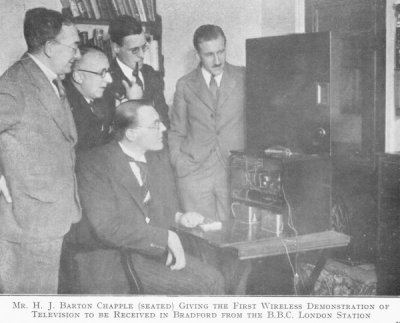
The Postmaster General's report, which was issued on 27th March, placed the official seal on Baird's system as 'a noteworthy scientific achievement,' and agreed to the use of a BBC station for progressive experimental transmissions. However, the BBC, in what can only be described as clear show of deliberate obstruction, offered but three transmission periods per week of fifteen minutes at 11 am, with no guarantee of continuity, and negotiations broke down. Thompson's tenure as Postmaster General had expired and the BBC possibly thought that with Baird's main supporter now gone from his position of influence, they could once again close their eyes to the development of the new medium. But Mr Lees-Smith, the new Postmaster General, proved to be no less a Baird supporter than his predecessor, and again pressure was bought on the BBC to improve its offer. As such five half-hours a week were granted for transmissions. However, it would appear that the pressure the BBC was under was not all in the name of entertainment.
According to Jeffrey Cohen 'in a letter to the Admiralty, the Baird Company offered to withhold details of the latest equipment from the public if the Admiralty so wished. At this time TV pictures were still very poor and much work was needed. So the Lords of the Admiralty wrote to their counterparts in the Air Ministry about how further research could be stimulated: 'A perfected scheme of television cannot fail to have important bearing on military problems,' and, they concluded, the best strategy would be to 'allow commercial interests to speed television development.' This suggests that they realised that the way forward was to encourage the start of broadcast TV, which would increase competition to produce better pictures.'
Even with forced concessions the BBC still managed to make life difficult for Baird by refusing to meet the cost of his test transmissions, and in stark contrast to the support that television developers were receiving elsewhere in the world wherever television experiments were taking place, Baird had to pay the BBC for the use of their transmitters. Clearly the BBC resented the fact that they had been forced to accommodate Baird who later wrote: 'The BBC bowed to the decision with very bad grace, did what they could to give us as small facilities as possible, and made conditions difficult for us.' From March onwards Baird met with the BBC to try and agree a timetable for use of their facilities, but it wasn't until September that an agreement was finally reached. In her book Television Baird published in 1973, John's wife Margaret Baird noted: 'What may have helped the final agreement was Captain Eckersley's resignation from the BBC, following his divorce.'
On Monday morning 30th September 1929, John Logie Baird stood in a corner of the studio in Long Acre and witnessed the inaugural broadcast of television carried through the BBC transmitter 2LO for half an hour. The Right Honourable William Graham, President of the Board of Trade and member of the British Cabinet read a message stating how he looked forward to 'this new applied science' to encourage and provide a new industry, not only for Britain but the rest of the world. Summing up, Mr Graham said that television would; 'encourage closer relations between communities at home and abroad and provide a new avenue for educational development.'
This and subsequent broadcasts on this day were sent from one transmitter only and sound and vision had to be sent alternatively. From 31st March 1930 however, two wavelengths were allotted, the sound being transmitted from one, and the vision from the other simultaneously. For this inaugural transmission of sight and sound a Televisor was installed at 10 Downing Street to allow the Prime Minister, J. Ramsay MacDonald, to enjoy the programme. In a personal letter to Baird, dated 5th April 1930, MacDonald wrote; 'What a marvellous discovery you have made!'
On the 8th May 1931 Baird gave a demonstration of the televising of street scenes in normal daylight. A van was drawn up in Long Acre and a revolving mirror drum picked up the scene, which was transmitted by landline to watching press representatives. 5 days later, on 13th May, Baird's apparatus was installed in No 11 Downing Street for an interview by the newspaper the Daily Herald. In its editorial comment the following day the newspaper reported: 'When the Daily Herald interviewed Mrs. Snowden yesterday by television, and watched her image on the screen throughout the conversation, yet another of the dreams of science passed into the realms of fact...It is proof positive to the most hard-bitten sceptic that television is rapidly passing from the experimental to the commercial stage - quicker, in fact, than the bulk of people imagine...It was a British triumph.'
During the summer of 1930 Baird had stated in public that, given the facilities, he could transmit the Derby by television. Once again, his critics raised doubts, some ridiculed him and some insulted him. Even many of his friends were doubtful of the wisdom of publicly announcing this ambitious experiment. But undeterred, Baird set about making arrangements to televise the horse race on 3rd June 1931. On the day, the Baird caravan took up a position against the rails almost opposite the winning post, and after supervising the installation, Baird returned to his Long Acre studio to take charge of a long row of receivers. The scenes were sent by landline to Long Acre, and also broadcast by the BBC, which had only allowed Baird a minute voltage for the broadcast causing the picture to flicker with interference. However, despite the BBC, the Derby Day transmission was yet another triumph for Baird. J. Earnest Jay, special correspondent of the Daily Herald, wrote: 'The result astonished us all. We had found the stepping-stone to a new era in which mechanical eyes will see for us great events as they happen and convey them to us at our homes...'
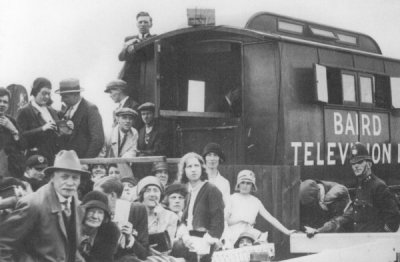
"The Derby proved to be a tremendous stimulant to the television cause", John Swift wrote in his 1950 publication Advenure in Vision. It showed what could be achieved almost at a moment's notice, without the aid of artificial light and in circustances bristling with technical difficulties. The fact that the broadcast was made possible by a land-line connection between Epsom and Long Acre was immaterial. The feat served as a pointer to the possibilities of outside broadcasts and studio productions under ideal conditions."
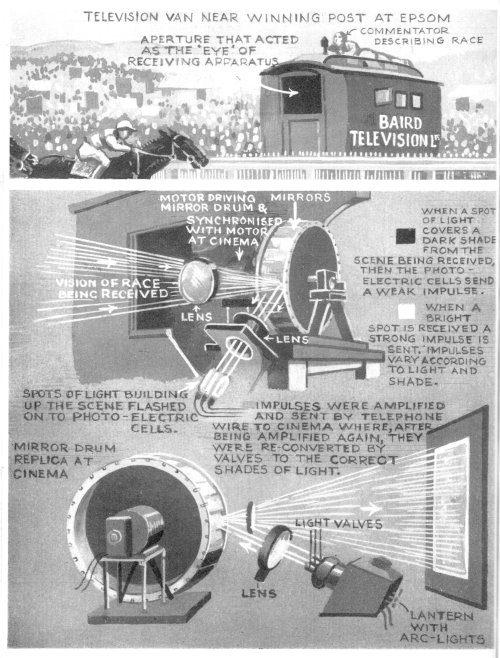
From 15th October 1931 Baird's television was introduced into BBC broadcast hours as a weekly feature, previous transmissions being in the morning or after midnight. Many different forms of 'entertainment' were experimented on in the course of refining the quality of the transmitted picture including music and dance with the first ballet performance going before the experimental cameras. Unfortunately, there are no records to substantiate the exact date although the ballerina Ailsa Bridgewater wrote to Television magazine in 1935 that the transmission started at midnight. This would place the date prior to October 1931 but after March 1929. Ms Bridgewater went on to write that; 'Owing to the fact that a full-length picture was then impossible, after a short introductory speech I mounted the stage which was more in the form of a table than anything else, and commenced to show the rudiments of ballet technique within the carefully marked out space.'
It is obvious from the rest of her letter that Ms Bridgewater was perfectly aware of the historical significance of her performance as she goes on to state that; 'From the moment when the red light showed suddenly and brightly, and the immediate "all quiet please" came from the announcer, an indescribable feeling of romance inevitably pervaded the next half hour. Despite a certain amount of natural nervousness at facing both the microphone and the Televisor, to a far greater extent was the thrill and realisation that this was the foundation of a new means of presenting the art of dancing to the public.' That Ms Bridgewater was aware of this significance is no doubt due in part to the fact that her brother was now working for Baird as one of his engineers.
Despite being seen as something of a romantic figure in the history of television development, it should be noted that by now Baird had assembled a number of engineers working on his ideas. Thornton Bridgewater had first applied to Baird for a job in 1928. Baird interviewed him and showed him around his laboratory "with a quiet courtesy which I later discovered to be a constant attribute, remarkable for one by nature so impatient." According to Bridgewater, Baird never stopped inventing although he was "no academic theorist." Everything he thought of he wanted to test. "The trouble was that there was never time to try everything, and one could not help feeling sorry for his restless nature, watching him as he paced up and down the laboratories, looking in at one after the other. He always wanted to see things, to see results, to see his ideas in practice. Paper meant nothing to him. In fact, most of his inventions and calculations were worked out on wooden partitions of the building; they were simply covered with his sketches."
Another engineer, D. R. Campbell was particularly struck by an extremely minor incident that convinced him about the future of television on the day before the Derby transmission when the equipment was being tested. "I was in the studio at Long Acre, watching a test transmission from Epsom. I noticed a tiny patch on the screen. It was moving and coming slowly nearer. It might have been a horse, a dog or a human being, but as it got nearer the rails I saw that it was a policeman. He walked up to the caravan that housed the equipment and I saw clearly the rain dripping from the peak of his helmet and glistening on his oilskin cape. There was something in that simple picture that made be realise - how I really don't know - that television was going to be a power to contend with."
In 1932 Baird built on his triumph of the previous year by transmitting the Derby to an expectant audience at the Metropole Theatre, Victoria. He used three telephone lines from Epsom and sent three pictures, which were transmitted side by side into one large picture 7 feet high by 9 feet wide. Again the BBC only allocated Baird and his technicians a limited amount of power. However, unbeknown to them Baird's men increased the voltage ten-fold, it resulted in the clearest pictures ever received and no one at the BBC was any the wiser. As the horse, April the Fifth, passed the winning post first, the audience at the Metropole stood and cheered. It was another public success for John Logie Baird.
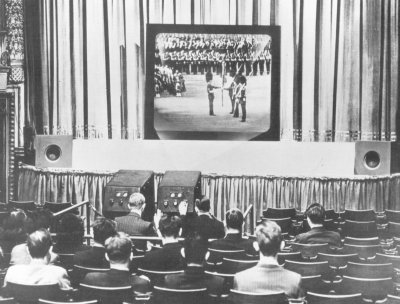
By May 1932 the BBC were ready to start their own research into television production. To aid them they set up their first TV studio in the recently purchased Broadcasting House and employed their first television engineer, Douglas Birkinshaw. Both Campbell and Bridgewater joined him, and Baird's equipment was installed in the new premises. But by now, John Baird himself was merely an employee of the company that bore his name.
In 1930 Baird's shares had fallen dramatically and by June of that year it was necessary to amalgamate the Baird Television Development Company and Baird International Television Ltd into Baird Television Ltd. Soon after this, the parent company, Television Ltd went into voluntary liquidation. This company held one million deferred shares (a controlling interest) in the public company. Baird's financial adviser, Sydney Moseley, secured these shares from the liquidator and the controlling interest was purchased by Isidore Ostrer, the managing director of Gaumont-British film company in January 1932.
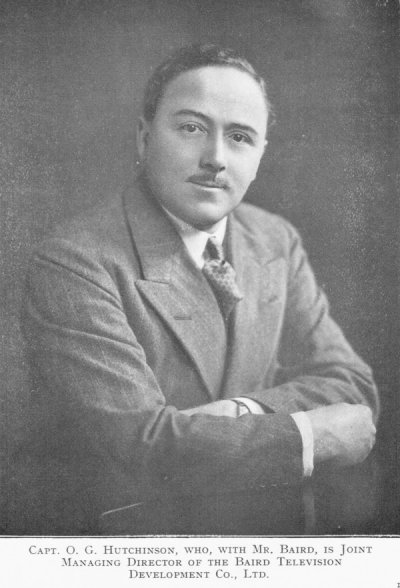
Baird's reaction to this was to withdraw to his laboratory and continue research on several new projects. One of these was the development of ultra-shortwave transmissions. Medium waves, as used by the BBC, permitted no more than a certain amount of detail, which limited Baird to transmissions of 30 lines. Their main advantage was their ability to carry signals for hundreds of miles. Ultra-shortwave allowed much more detail but limited the range to about forty miles, although a series of relay transmitters would allow the pictures to go much further. On 29th April 1932, Baird gave a demonstration from his ultra-shortwave transmitter at Long Acre, the pictures being transmitted to a 30-line receiver at Selfridge's.
The following year Baird, now married and a father to his first child, moved to 3 Crescent Road, Sydenham. The house was chosen for its close proximity to the Crystal Palace, a vast glass and metal building that had originally been designed by Paxton in 1851 for the Great Exhibition. In 1933 the Baird Company rented part of the Palace. Baird used the south tower for his ultra-shortwave experiments, and by 1934 he was televising 180-line images to a cathode ray tube screen, giving images 10 by 8 inches.
With the possibility of high-definition television, in May 1934, the Postmaster General decided to set up a committee to advise him on the development of the medium and the merits of the systems available. Rivals to Baird were now emerging and one of them was Marconi-EMI. (Later changed to EMI-Marconi). Marconi-EMI was developing a system that operated on all-electronic lines and by 1935 they were offering an interlaced system of 405 lines, as opposed to Baird's 240 lines. Marconi-EMI's Emitron camera was based on the RCA Iconoscope developed by Vladimir Zworykin, although the company vigorously denied this. However, Zworykin had handed over several patents on the Iconoscope camera to Marconi Wireless and Telegraph Company in Britain as early as 1932. Furthermore, when RCA President David Sarnoff returned to New York in 1937 following a trip to Europe he commented: "Under an exchange of patent licences this British company may use RCA patents in England and, in turn, its American licensees may use British patents in the United States." It should also be noted that when RCA was created after the First World War, one of the companies it absorbed was the Marconi Wireless and Telegraph Co. of America.
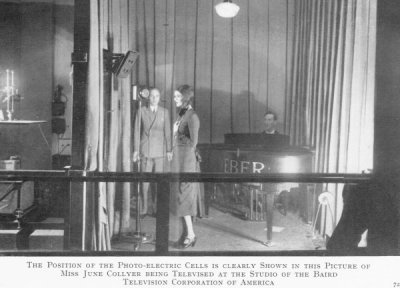
Baird firmly believed that the Baird Company should join forces with one of the larger companies. 'The Marconi Company got in touch with us in 1932 and were anxious to join forces' he later wrote. 'We had numerous meetings, I went up to Chelmsford and was shown around their television research department. Many meetings and luncheons followed and the whole stage was set for a merger.' But according to Margaret Baird, John was reckoning without the board. 'He had never felt at ease with a number of members of the board, who seemed to regard the company as an organisation for selling sets rather than as one for research.' Even though John had his supporters within the company, when it came to a vote on the merger, the board rejected it. There was also an attempt to merge with the General Electric Company Ltd., the chairman, Lord Hirst, was a friend of one of the Baird board members who supported John. 'The immense importance of such a tie-up was very obvious to me' wrote Baird. 'Although we got as far as having regular technical meetings and our own research departments were working in unison, at the last minute Isidore Ostrer turned the whole thing down.'
The committee set up by the Postmaster General was headed by Lord Selsdon and included the BBC's (then) chief engineer, Noel Ashbridge, and the Controller, Admiral Carpendale. The Selsdon Committee returned its report on January 4th 1935. Among the recommendations made were that competition or commercial operation was undesirable as was a low-definition service and that a format of not less than 240 lines should be employed. The decision to accept these recommendations caused a flood of complaints. When news got out that low-definition broadcasts would stop in September 1935, viewers from as far afield as the north of England and Scotland complained that the Government had totally disregarded them by accepting a service that would only cover the London area. The Royal Television Society backed these views and urged the BBC to continue with 30 lines. The Society's president, Sir Ambrose Fleming accused the BBC of being "the perfect autocracy", and "an uncontrolled monopoly." He also declared that the overcautious and unenterprising spirit of the BBC was holding television back.
It is now a popular held belief that Baird's system was far inferior to the one produced by Marconi-EMI and was doomed to failure from the start. However, the low-definition device that Baird used was capable of giving a better definition of detail than a high definition one. The mechanically scanned pictures needed fewer lines than the electronic system to give good pictures as a result of the higher contrast in the television image points. The leading German scientific writer, Dr Alfred Gradenwitz, remarked on the unusual clarity of Baird's 30-line pictures and was impressed by the "outstanding wealth of detail." Further praise came from American radio pioneer Lee De Forest who wrote to the National Radio Institution of America in 1934 where he observed that Baird was limited by British regulations to 9,000 kHz side bands. 'Imagine getting a good picture out of that!' he wrote. 'Yet Baird does it -by the use of a 30-line picture and 12½ pictures per second. Considering the handicaps, the results are amazing.' It is also worth pointing out that the limitations Baird worked with, that De Forest so clearly pointed out, were as a result of the bandwidth that was allocated to Baird between 1930 and 1935 by the BBC.
But while it was becoming increasingly obvious that behind the scenes the BBC were deliberately imposing restrictions on Baird that would severely limit his system, they promoted an entirely different public image. The Selsdon Committee recommended that both the Baird and Marconi-EMI systems be run side by side for a trial period to decide which one would be adopted by the Corporation. But the trials were in the hands of BBC engineers and before the opening date for television of November 2nd, the Baird system was beset with problems, there were even suggestions of sabotage. It has been said that the Baird system was unreliable and constantly breaking down even after the daily transmissions started, but none of this was evident prior to the run-in for the start of the service.
EMI's equipment was based on their all-electric Emitron camera, capable of transmitting 405 lines interlaced at 25 images per second. The Baird Company's system was a mechanical one of 240 lines sequentially scanned at 25 images per second. Baird used two systems. One, the fly spot camera, scanned with a fast moving spot of light necessitated the subject being in a dark room. The second was an intermediate camera, which recorded both image and sound. The film was fed from the camera to a tank containing the chemicals required for developing it. A fly spot Nipkow disc transmitter could then scan the processed film, whether wet or dry, and the images were observed on a cathode ray receiver. The delay between filming and conversion was 45 seconds. This process was called the 'Intermediate Film Technique' - and it threw up its own unique problems: underwater air-bubbles interfered with the sound, and it needed a lethal cyanide developer to get the processing time down to 'almost instantaneous.' The lurid orange developer was notorious for leaking out of the system and on to the studio floor. It soon became apparent that the Baird intermediate film system was still virtually at the experimental stage.
However, Baird also used an electronic camera. In February 1935, the press had witnessed the transmission of simultaneous sound and pictures from one room to another at the Crystal Palace laboratory using an electronic camera giving pictures with a definition of 700 lines, 295 more than EMI. Baird had informed the Selsdon Committee in 1934 that he could easily go to 700 lines, the main drawback being that such definition would drastically limit the transmission range without the use of expensive booster stations. In the end Baird decided to go for the maximum range whilst staying just inside the Selsdon Committees recommendation of transmissions of not less than 240 lines. But an article dated 2nd March 1935 in Practical and Amateur Wireless had claimed that at 180 lines Baird's television images were 'bright and clear, with considerable detail, while at no time did they 'hunt' or go out of synchronism.'
Camera sensitivity proved to be an ongoing problem for EMI, especially when it came to outside broadcasts, an area in which Baird had already proved himself. And the Emitron camera proved virtually useless for film as its image storage ability caused an image to be retained from one frame of the film to another, causing blurring. The main advantage it had over the Baird system was its portability. Baird's 240-line camera was cumbersome and had to be bolted to the floor. Baird had already alerted the company to this drawback but found that his advice fell on deaf ears. As he was now 'employed' by his company rather than running it himself he found he was powerless to do anything about it.
On 2nd November, at 3.00pm, the official opening of the BBC television service, using (for the first week) the Baird system, commenced from Alexandra Palace. The first programme was presented by the Postmaster General, Major G.C. Tryon, followed by a programme featuring the Chairman of the BBC, R. C. Norman and Lord Selsdon. Other speeches were made by Sir Henry Greer, Chairman of the Baird Television Company and Alfred Clark, Chairman of EMI. One person was conspicuous by his absence: John Logie Baird. In possibly the ultimate insult the BBC could deliver, the man who had given television to the world, was simply not invited. In his biography Sermons, Soap and Television Baird wrote of the BBC: 'What the devil had they done for television? But there they sat sunning themselves in the limelight as the men responsible for this great achievement, for so they wished to appear.'
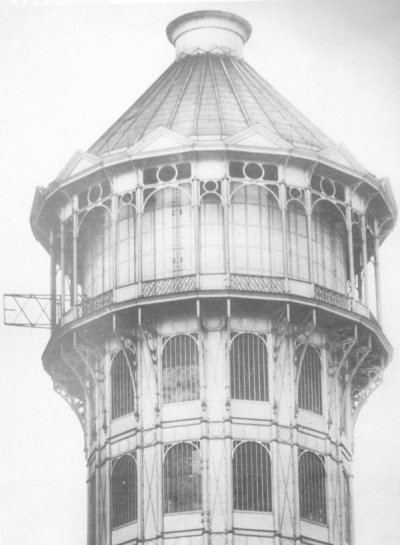
The trial by television for Baird and EMI continued with each system being used on alternate weeks. But just four weeks after the opening ceremony, on 30th November, Baird was dealt the cruellest of blows. At approximately 7.30pm flames were spotted in the central section of the Crystal Palace. Within minutes the structure was engulfed in a raging inferno. Glass cracked and fell continuously, and mounted police had to clear back thousands of onlookers. Amongst them was John Logie Baird whose experimental television equipment was housed in the South Tower. Before the fireman could reach that section, the intense heat brought down the southwest wing.
To the outside world it may have seemed that the Crystal Palace laboratory was no more than that; a simple workshop where the inventor could continue his television experiments at the tolerance of his new bosses. But between 1933 and 1936 the most extensive television complex in Europe was located beneath the main concourse at the Crystal Palace, a fact that until years later was unknown to most people. At Crystal Palace the Baird Company had three sizable studios which were comprehensively equipped and acoustically isolated. The largest of these measured 60 ft. by 40 ft. and could accommodate full-scale productions. Other facilities included telecine equipment, dressing rooms, a generating plant, workshops, offices, and sound and vision radio transmitters. So little was known regarding the existence of these facilities that for years later (and today still in some cases) photographs taken there were attributed to Alexandra Palace.
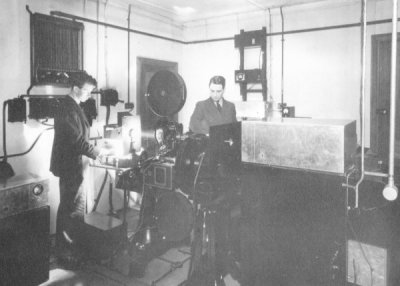
Baird had always wanted to set himself up as an independent broadcaster and to prove the capability of his equipment at the fifth Annual General Meeting of the Baird Company, he surprised the shareholders by having the chairman, Sir Harry Greer, appear on a television screen, transmitted from Crystal Palace to their Wardour Street meeting place, to deliver the company report. While Greer made his way back to the West End of London the shareholders and the press enjoyed a variety show and excerpts from films. From February until June 1935, over 42 programmes were transmitted from the studios to various locations in London and over forty transmitters were made. Mechanical scanning was used for the 240-line telecine machines. The possibility of recording television programmes on film aroused considerable interest and Baird was able to achieve this by the end of 1934 by using a high-intensity cathode-ray tube and a 17.5 mm cine camera. By using fast processing techniques, the recorded television images could be developed, fixed, washed, dried and then projected on to a large screen within two minutes.
The company seemed to be ready to go into full-scale production by the time the Selsdon Committee had completed its report, but following the conflagration, only the South Tower, the School of Arts and the Rotunda in the Palace Grounds survived. Baird lost almost £100,000 worth of equipment that night including research records that were irreplaceable. It seemed as though fate had dealt him a cruel blow, but the truth may have been far more sinister.
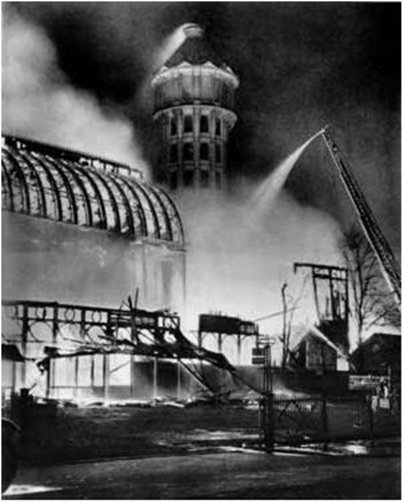
Before the contest with EMI, further work had taken place on Baird's Noctovision, which he saw the potential of developing for a practical use. Following numerous tests Baird invited journalists and scientists to his house at Boxhill where he demonstrated the equipment's ability to pick up the navigation lights of ships at sea, or the rays of a lighthouse, and determine their relative bearings. Mercantile Marine officers who attended these tests were of the opinion that the equipment's development offered vast potentialities in the safe navigation of vessels in foggy weather.
In December 1934, the Air Ministry set up a committee to find ways of protecting Britain from possible attack from enemy aircraft, and by January of 1935 that committee held its first meeting. The committee came to the conclusion that Britain needed at least twenty minutes warning of approaching aircraft and the best method of detecting them would be from reflected radio waves. Sir Robert Watson-Watt, a Scottish physicist, was put in charge of developing such a system and on 26th February he conducted his (now famous) first experiment from BBC Daventry. Or so history would have us believe. It would seem that Watson-Watt, who could not have been alerted to the Air Ministry's plans before January 1935, had by the following month, both devised and refined a system of radar. Fast work indeed! By June 1935 Watson-Watt was utilising a system very similar to Appleton's 1931 synchronised pulse signal, which was probably based on Baird's original experiments. Appleton joined the committee in October 1936 and it is reported that he was less than amused to discover his apparatus being used for British defence radar with Watson-Watt taking all the credit.
The British kept their experiments under close security, but it is known that the Germans were well aware of many of these developments. In June 1936 the German Secretary of State for Air, Erhard Milch, creator of the Luftwaffe, visited Hatfield Aerodrome. Apparently the first question he asked to a surprised British delegation when he stepped off his plane, was how their radiolocation was coming along.
Baird in the meantime was employed elsewhere on Air Ministry projects secretly equipping bombers. In 1936 the Ministry approached Captain A.G.D. West, chief engineer of the Baird Company and himself an ex-radio intelligence officer. They wanted a television guidance system to direct bombers from above the clouds. West informed the Ministry that the Baird Company had business ties with Fernseh AG in Germany and under the agreement of their partnership, exchanges of technical information were mandatory. However, it was noted that the German government had taken control of all television, declaring that all future development was to be a state secret. Since then, Fernseh was soaking up all the information they could from the Baird Company without giving anything in return.
An Air Ministry file in the Public Records Office reveals that the Baird Company were contracted to develop a bomber guidance system for the French government and possibly for the Russians too. Both contracts had British government approval. In Germany, Baird's activities were already under close scrutiny and for a country that was preparing for war, the Baird Company, working closely for Germany's intended enemies, would have been a prime target. During the period when the company undertook secret work, it would almost certainly have attracted the attention of German agents. The German leadership was only too aware of the importance of television and its closeness to radar and other detection systems. This might lead one to the possible assumption that the fire at the Crystal Palace was not caused, as has been surmised in the past, by a mere electrical fault. The fire brought about massive disruption to the company's Air Ministry work, and Baird himself was convinced that this was nothing less than an act of sabotage.
